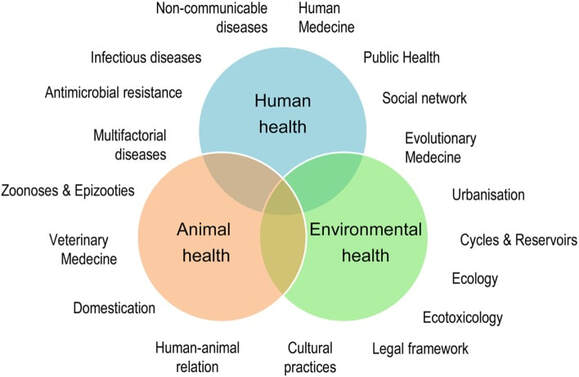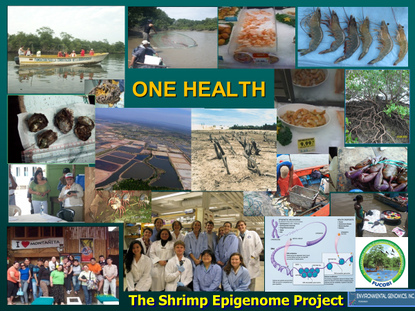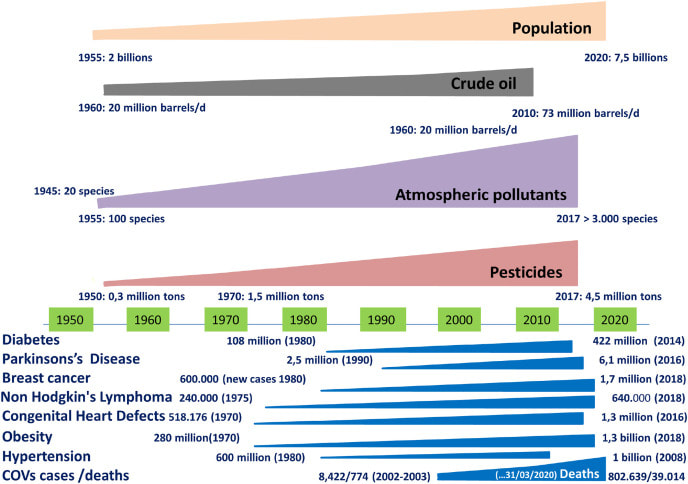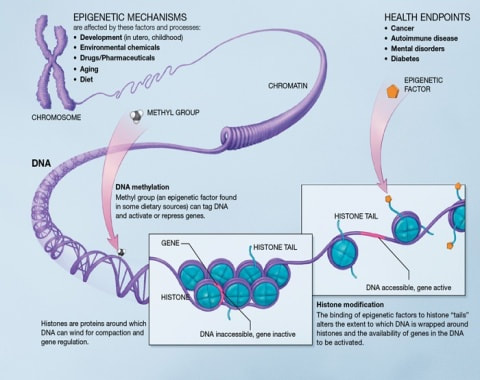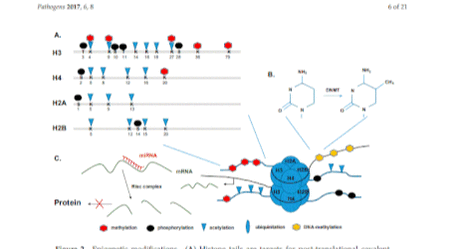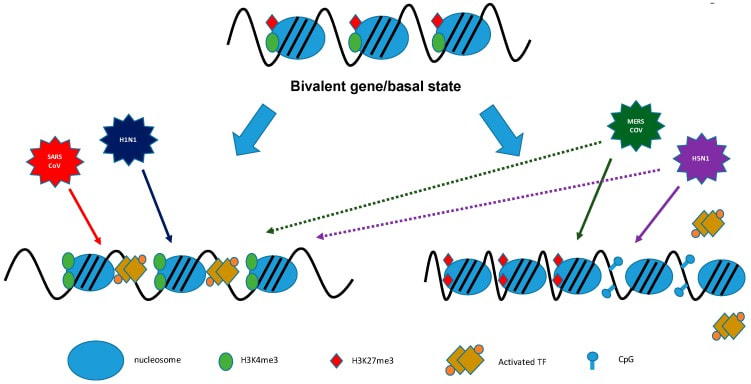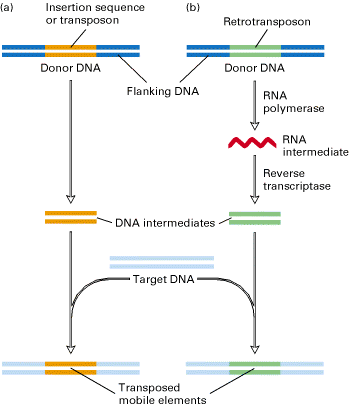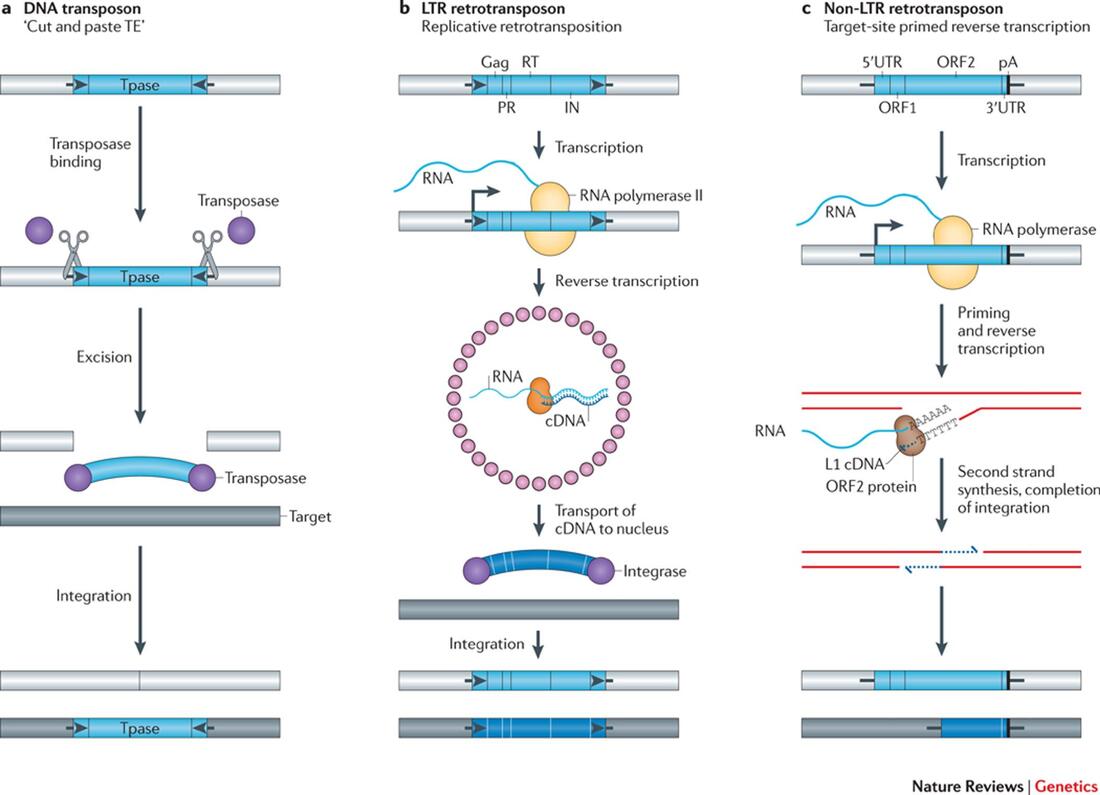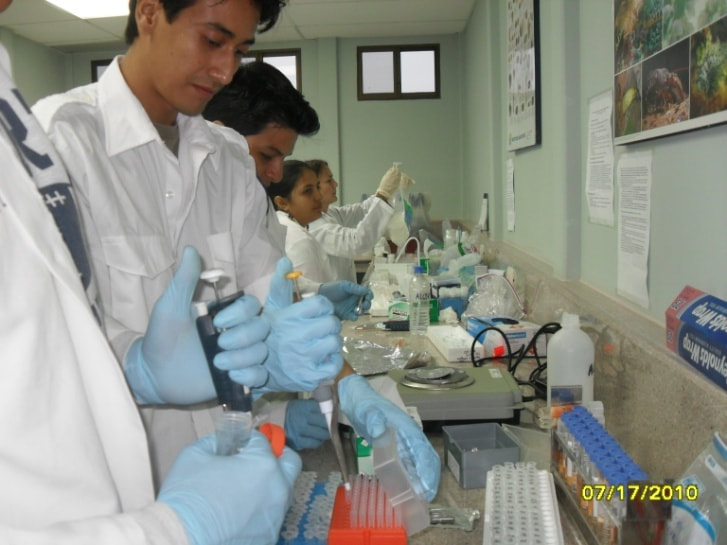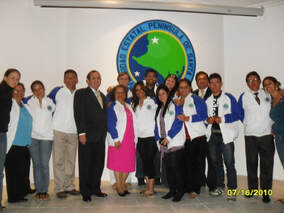- HOME
- SERVICES
-
ONE HEALTH Epigenomics and Microbiomes, From Soil to People
-
ONE HEALTH PROJECTS
>
- THE MANGROVE EPIGENOME (MangroveENCODE) PROJECT >
-
THE SHRIMP EPIGENOME (ShrimpENCODE) PROJECT
>
- penaeid shrimp genomes
- pilot genome sequence of first SPF Penaeus vannamei
- epigenetic genes of shrimp
- transposable elements of Penaeus vannamei
- contaminants of wild and farmed shrimp (metals, glyphosate, Bt, EDCs)
- glyphosate-free shrimp feeds
- transgenerational toxicological effects of glyphosate on shrimp
- THE COASTAL PEOPLE EPIGENOME (ChildrenENCODE) PROJECT >
-
ONE HEALTH PROJECTS
>
- ONE HEALTH NEWS!
- PUBLICATIONS
- MEETINGS - ADWARDS
- CONTACT US
GENETIC EPIDEMIOLOGY
The relatively young field of genetic epidemiology brings together genetics, epidemiology and biostatistics to identify and implement the best study designs and statistical analyses for identifying genes controlling risk to complex and heterogeneous diseases. The field has moved quickly over the past 40 years partly because the technology of genotyping and sequencing has forced it to adapt while adhering to the fundamental principles of genetics and epigenetics. The available tools for genetic epidemiology have expanded from a genetic focus (i.e. considering one gene at a time) to a genomic focus (i.e. considering the entire genome), and now they must further expand to integrate information from other "-omics" (e.g. epigenomics, transcriptomics) both at the individual level and at the population level. The gene and environmental interactions across populations can now be evaluated to better understand exposure and the heterogeneity in disease risk.
ONE HEALTH EPIDEMIOLOGY:
SARS-Cov-2 IN WASTEWATER
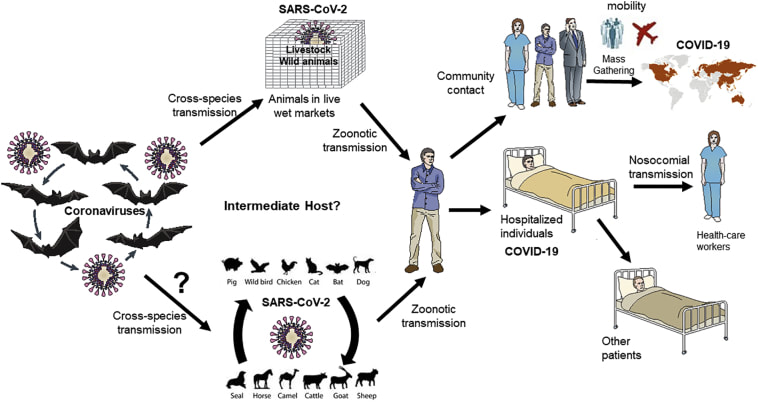
Fig. 3. The emergence of SARS-CoV-2 and the outbreak of COVID-19. The figure depicts a hypothesized origin of the virus and a generalised route of transmission of the epidemic zoonotic coronavirus. Taken from El Zowalaty and Järhult. 2020. From SARS to COVID-19: A previously unknown SARS- related coronavirus (SARS-CoV-2) of pandemic potential infecting humans – Call for a One Health approach. One Health. 2020 Jun; 9: 100124Published online 2020 Feb 24. doi: 10.1016/j.onehlt.2020.100124
https://www.ncbi.nlm.nih.gov/pmc/articles/PMC7228230/
Long-term exposure to anthropogenic pollutants, among other risk factors, may have a positive association with chronic diseases such as neurodegenerative disorders (e.g., Parkinson's disease) and diabetes, breast cancer, non-Hodgkin's lymphoma, cancer, leukemia, obesity, congenital heart defects, hypertension,and increased vulnerability to microbial and viral infections and their mortality (Figs. 4 and 5).
There is a need for anthropological and scientific approach for the evaluation of the association of the global production of crude oil, atmospheric pollutants, and pesticides with the population growth and chronic diseases trends.
EGI is concerned about the threat to aquatic ecosystems caused by disinfectants using during the COVID-19 pandemic (Zhang et al. 2020, https://science.sciencemag.org/content/368/6487/146), and we are offering research awards to veterinary medical students to address these issues.
There is a need for anthropological and scientific approach for the evaluation of the association of the global production of crude oil, atmospheric pollutants, and pesticides with the population growth and chronic diseases trends.
EGI is concerned about the threat to aquatic ecosystems caused by disinfectants using during the COVID-19 pandemic (Zhang et al. 2020, https://science.sciencemag.org/content/368/6487/146), and we are offering research awards to veterinary medical students to address these issues.
EPIGENETICS
Epigenetics is the regulation of gene expression through alterations in DNA or associated factors (other than the DNA sequence). These factors control the diverse manifestations of diseases. Advances in epigenetics link genetics to the environment and disease (Fig.6).
Fig. 6. Epigenetic components.- DNA methylation, histone methylation and acetylation, non-coding RNAs (microRNA)) are affected by various factors and processes: development (in uterus, childhood), environmental chemicals, drugs / pharmaceuticals, aging, diet, which impact health (cancer, autoimmune disease, mental disorders, diabetes, others).
Examples of epigenetic modifications by infections with highly pathogenic coronaviruses and influenza viruses are presented in Figs. 7 and 8.
|
Fig. 7. Epigenetic landscape during coronavirus infection. (A) Histone tails are targets for post-translational covalent modification. Particular lysine residues (K) can be methylated, acetylated, phosphorylated, and ubiquitinated, and particular serine residues (S) can be also phosphorylated. (B) DNA is being methylated by transferring a methyl group to the C-5 position on cytosine bases. (C) miRNA, usually 22nt long, bind the 3’-end of their target mRNA with their seed region and mediate the degradation of the mRNA by incorporation into RISC. DNMT: DNA methyltransferase; mRNA: messenger RNA; miRNA: microRNA; RISC: RNA-induced silencing complex; K: lysine; S: serine; T: threonine. Taken from Schäfer & Baric 2018.Epigenetic Landscape during Coronavirus Infection. Pathogens. 2017 Mar;6(1):8.
|
Fig. 8. Epigenetic modification by infection with highly virulent respiratory viruses, pathogenic influenza viruses and coronavirus. Epigenetic modification induces changes in the basal state of host chromatin. Infection with H1N1-09 (blue) and SARS-CoV (red) results in enrichment of H3K4me3 incorporation (green ovals) and depletion of H3K27 (red diamonds), and therefore in open, transcription-active chromatin. In contrast, H5N1-VN1203 and Middle East respiratory syndrome coronavirus (MERS-CoV) infection drives H3K27me3 enrichment and depletes H3K4me3 for a subset of genes, favoring a closed chromatin conformation that inhibits interferon-stimulated gene (ISG) expression. Taken from Schäfer & Baric 2018.Epigenetic landscape during coronavirus infection. Pathogens. 2017 Mar;6(1):8.”
|
Epigenetic changes after infection with shrimp viruses (WSSV, IHHNV) and Vibrios that cause AHPND disease are presented in The Shrimp Epigenome (ShrimpENCODE) Project section.
TRANSPOSABLE ELEMENTS (TEs)
Transposable elements are divided in two classes: (A) Transposons, which transpose directly from DNA to DNA and (B) Retrotransposons, that use reverse transcriptase to transpose by means of an RNA intermediate (Figs. 9 and 10).
TRANSPOSABLE ELEMENTS OF SPECIFIC PATHOGEN-FREE (SPF) |
P. vannamei
|
Transposable elements play essential roles in epigenetics and regulation of the immune system of shrimp. Over 300 repetitive sequences / transposable elements (TEs) have been characterized from the first SPF P. vannamei produced in the USA by EGI collaborator, Dr. Weidong Bao, at the Genetics Information Research Institute (GIRI), CA USA. For example, a hemocyanin promoter gene contains most of the Penelope-5_LV non-LTR retrotransposon. A transcript containing L1-like sequences was identified in transcriptome of ‘SPF’ P. vannamei infected with WSSV farmed in Brazil (Santos et al. 2019), but is not present in the draft genome sequence assembled for farmed P. vannamei from China (Alcivar-Warren, 2020). Some shrimp TEs represent endogenous virus of shrimp like white spot syndrome virus (WSSV), WSSV-EVE, and IHHNV-EVE. A chimeric Taura syndrome virus (TSV) sequence has also been found in P. vannamei farmed in the Philippines.
helping to train the next generation
EGI support local and international students – citizens science projects, basic research, and laboratory teaching projects. We donate laboratory supplies and small equipment to collaborators for conservation genetics and disease diagnostics projects.
ONE HEALTH EPIGENOMICS – A GLOBAL EDUCATIONAL INITIATIVE (OHEEI)The OHEEI was initiated by high school students from Massachusetts to assess the adverse health effects to the environment, wildlife, pets, seafood, and people, caused by the antimicrobial herbicide Glyphosate (RoundUp) and other endocrine disrupting chemicals (EDCs) like metals and Bisphenol A (BPA).
|
SHRIMP SCAMPIA citizen science project to (a) review the scientific literature about epigenetic mechanisms associated with EDCs [Glyphosate (G), metals, BPA] associated with antimicrobial resistance, diabetes, obesity, brain development, and neural tube defects (NTDs), and (b) examine the levels of glyphosate and metals in fresh and frozen shrimp sold at USA supermarkets.
|
ONE HEALTH EPIGENOMICS AWARDS FOR VETERINARY MEDICINE STUDENTS FROM LATIN AMERICA, AFRICA AND SOUTH EAST ASIA-To diagnose pathogenic WSSV, non-pathogenic WSSV-EVE and endogenous Nimavirus (Nimav-1LVa).
-To study glyphosate’s impact on your health: exposed before birth, generational impacts, cancer (non-Hodgkin lymphoma), endocrine disruptor, gut microbiome disruptor, non-alcoholic fatty liver disease. -TGEI -generational toxicology research – shrimp fed diets using native versus GM-based soybeans. |
LABORATORY TRAINING
Teaching Ecuadorian students to isolate DNA for genetic diversity and disease diagnosis studies.
|
TRAVEL AWARDS FOR STUDENTS TO ATTEND THE ANNUAL MEETING OF THE NATIONAL SHELFISHERIES ASSOCIATION (NSA)
To present results about the topics included in our ONE HEALTH Epigenomics projects.
|
Photo used under Creative Commons from Arkansas Agricultural Experiment Station
- HOME
- SERVICES
-
ONE HEALTH Epigenomics and Microbiomes, From Soil to People
-
ONE HEALTH PROJECTS
>
- THE MANGROVE EPIGENOME (MangroveENCODE) PROJECT >
-
THE SHRIMP EPIGENOME (ShrimpENCODE) PROJECT
>
- penaeid shrimp genomes
- pilot genome sequence of first SPF Penaeus vannamei
- epigenetic genes of shrimp
- transposable elements of Penaeus vannamei
- contaminants of wild and farmed shrimp (metals, glyphosate, Bt, EDCs)
- glyphosate-free shrimp feeds
- transgenerational toxicological effects of glyphosate on shrimp
- THE COASTAL PEOPLE EPIGENOME (ChildrenENCODE) PROJECT >
-
ONE HEALTH PROJECTS
>
- ONE HEALTH NEWS!
- PUBLICATIONS
- MEETINGS - ADWARDS
- CONTACT US

